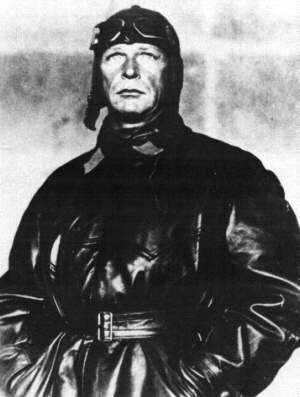
|
This photograph was used by the New York Times to identify Russian pilot Nicolai Juroff, who died flying the Maxim Gorky in 1935, then used again by the same newspaper to identify Sergei Danilin, navigator on a claimed transpolar flight from Russia to San Jacinto, California in July 1937 |
Russia’s Shortcut to Fame: A Fifty-Year Hoax Exposed
|
| A summary of Robert J. Morrison’s book, self-published in 1987, then published by Robert Hale Ltd., London |
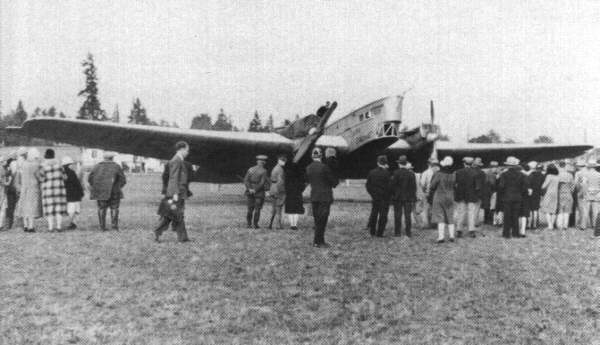
|
|
|
| Throngs of people inspect Semion Shestakov’s Land of the Soviets after the aircraft landed at Vancouver’s Pearson Field, following a multi-stop flight from Moscow to New York in the fall of 1929. The huge plane is believed to have been converted from a German Junkers K37. |
| Flight 1: Manned by Shestakov and three others. Landed at Vancouver, Washington on 16 October 1929 |
A flight from Moscow to New York with numerous refuelling and maintenance stops in the Land of the Soviets, a modified Junkers K-37. The stops included one near Sitka, Alaska, the region from which the subsequent “transpolar” flights probably originated. Chief pilot Shestakov claimed that the “Russian” plane could fly 2,500 miles without refuelling, which is extremely unlikely; due to frequent stops its outward flight had averaged only 150 miles/day. |
| Flight 2: Manned by Chkalov, Baidukov and Beliakov. Landed at Vancouver, Washington on 20 June 1937. |
The first claimed transpolar flight, in a “Russian ANT-25” which was actually one of a pair of French Dewoitine D 33’s which had crashed in Russian territory in 1931 and been rebuilt. So many inconsistencies exist in the claim of having flown non-stop over the North Pole that the US Government, headed by F. D. Roosevelt, must have known that it was fraudulent. Army General George C. Marshall, later Army Chief of Staff, Secretary of State, Secretary of Defense, Special Ambassador to China, architect of the “Marshall Plan” and winner of the Nobel Peace Prize, did his best to keep the heavy-drinking fliers in check and prevent the press from asking awkward questions before Troyanovsky, the Soviet Ambassador, arrived. |
| Flight 3: Manned by Gromov, Yumashev and Danilin. Landed at San Jacinto, California on 14 July 1937. |
The second claimed transpolar flight. After supposedly flying for 60-odd hours, the engine of the second ANT-25 “was absolutely clean of any oil and it gave the general appearance of an engine having just been completely cleaned. The exhaust smudge on the fuselage was exceedingly light.” The Air Force personnel who inspected the aircraft remarked that the general workmanship “was very poor, welding was poor, riveting unevenly spaced, the heads of rivets generally crushed, inferior painting, apparently brushed on, and the fabric very loose.” Russia’s Shortcut to Fame, p. 209 |
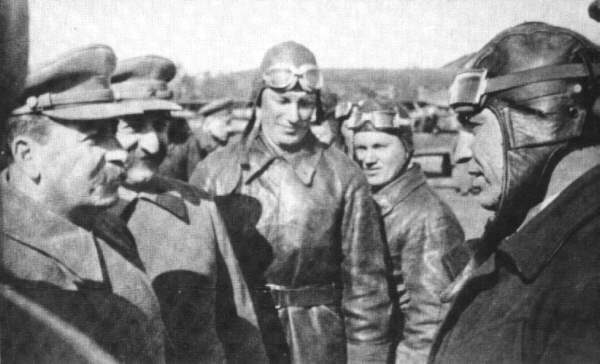
|
|
|
| Meeting at a military airport near Moscow are (left to right) Soviet Dictator Joseph Stalin; Sergei Ordjonikidze, head of Heavy Industry; Alexander Beliakov, navigator; an unidentified airman; and Valery Chkalov, pilot. This Russian photograph was used to give the impression that it was taken just prior to Pilot Chkalov’s departure on a non-stop “transpolar flight” to the United States June 18-20, 1937. Actually Ordjonikidze died under mysterious circumstances on February 18, 1937, four months before the first “transpolar flight.” |
‘The United States government followed these “transpolar flights” with keen interest, yet no high official raised any questions about their authenticity despite innumerable discrepancies and strange happenings. It was obvious the American government, including the departments of War and State and other key agencies within the Executive Branch, gave the Russian government total cooperation and assistance in the “transpolar flights.” The U.S. also honored Soviet requests to keep all information and correspondence confidential. Although the Soviet requests didn’t appear to be warranted, the U.S. stamped all the file material “Secret.” Why were these files made secret? The answers are buried deep in secret files, some of which have since been purged clean.’ Robert J. Morrison, Russia’s Shortcut to Fame, p. 206
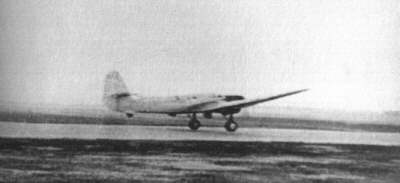
|
|
A photo from George Baidukov’s Over the North Pole (Harcourt & Brace, New York, 1938) supposedly shows the historic takeoff of an ANT-25 aircraft (with no markings on the right side of the fuselage) on a non-stop flight from Russia to the United States on June 18, 1937. When the aircraft landed in Vancouver, Washington two days later it had lettering on both sides of the fuselage. |
| :
|

|
|
This photo was reproduced from one frame of a video tape of a film produced by the Soviets to show the takeoff of an ANT-25 aircraft from Shelkova airport, near Moscow, to the United States on June 18, 1937. No markings are detectable on the aircraft. |
| :
|

|
|
This photo, taken shortly after the ANT-25 landed at Vancouver’s Pearson Field in Vancouver, Washington, shows lettering on the right side of the fuselage, which translates to “Route of Stalin.” |
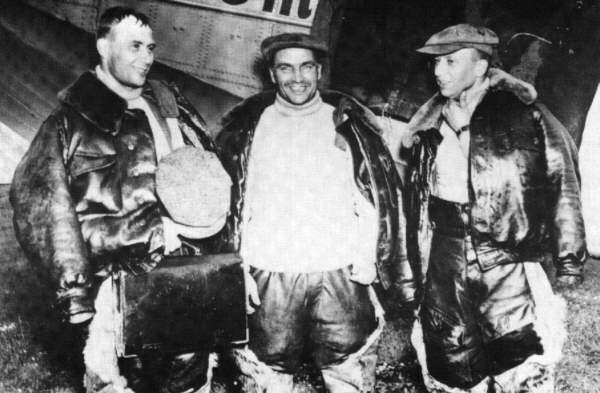
|
|
|
| Attired in artic flight gear, three Russian fliers (left to right), Alexander Beliakov, navigator; Valery Chkalov, pilot; and George Baidukov, copilot, pose at Pearson Field in Vancouver, Washington shortly after their arrival on June 20, 1937. |
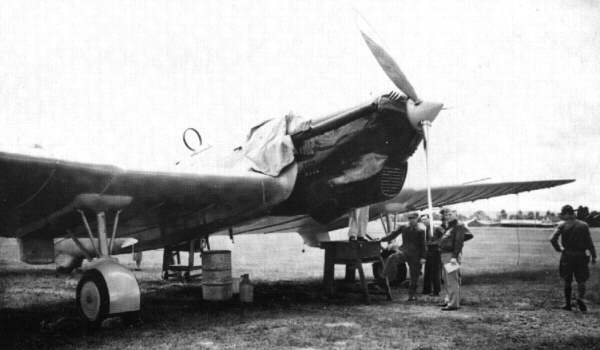
|
|
|
| Army General George C. Marshall, then commander of Vancouver Barracks, Vancouver, Washington, quickly orders soldiers at Pearson Field to throw a tarpaulin over the cabin of a Russian ANT-25 and places guards around the aircraft after it landed on June 20, 1937, following a claimed non-stop flight from Moscow via the North Pole. |
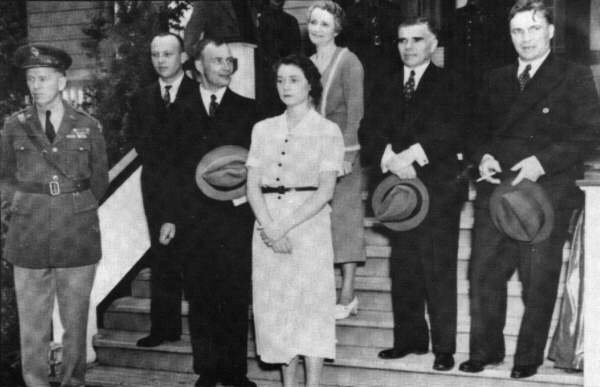
|
|
|
| Army General George C. Marshall, along with his wife Katherine (in background) and stepdaughter Molly Brown, host the Russian fliers. Also shown is Soviet Ambassador Alexander Troyanovsky. |

|
|
|
| Crowds gather around a Soviet ANT-25 aircraft that landed at a ranch near San Jacinto, California on July 14, 1937, supposedly after a second non-stop flight from Russia, via the North Pole. The poor workmanship of the aircraft is clearly visible on the tail airfoil. The plane used in this second “transpolar flight” does not have markings on the fuselage. |
‘Since the U.S. government appeared to lend credence to the “historic” happening, why should anyone doubt the authenticity of the flight? Gromov and his two flying comrades must have hoped that the Americans would remain as gracious to them as they had been to the first crew. They were soon to find out as they prepared to travel east to visit President Roosevelt and to tour U.S. factories. Before the end of July the Soviet pilots were scheduled to visit Consolidated, Douglas, Northrup, Boeing, Sikorsky, Glenn Martin, Wright, Pioneer Instrument, Sperry Gyroscope, and NACA Laboratories and Research, a firm associated with Langley Field, a large air force base in Texas. The flying trio were to be accompanied by some heavy names in Russian industry, such as Mikhail Kaganovich, commissar of Heavy Industry; Colonel Vladimir Begunov, military attaché; Stanislav Shumovsky, aeronautical expert; V. M. Petlinev, V. J. Vurgens, and V. K. Bogdon, all said to be knowledgeable in aviation.’ Robert J. Morrison, Russia’s Shortcut to Fame, p. 211
‘Two Soviet [atomic] explosions were detected in October 1951 (one on the third and one on the twenty-second). Most Americans accepted the bomb and speculated nervously on whether, or how, the Soviets were capable of delivering it to a target. On May Day, 1947, Western observers had identified B-29-like Soviet planes flying in formation over the Kremlin. These had apparently been patterned after American planes that landed in Siberia during the war. The Russians were also known to have copied German submarines, and these might be used to launch atomic missiles.’ William Poundstone, The Prisoner’s Dilemma (1992), pp. 134-135
–– The Heretical Press ––









